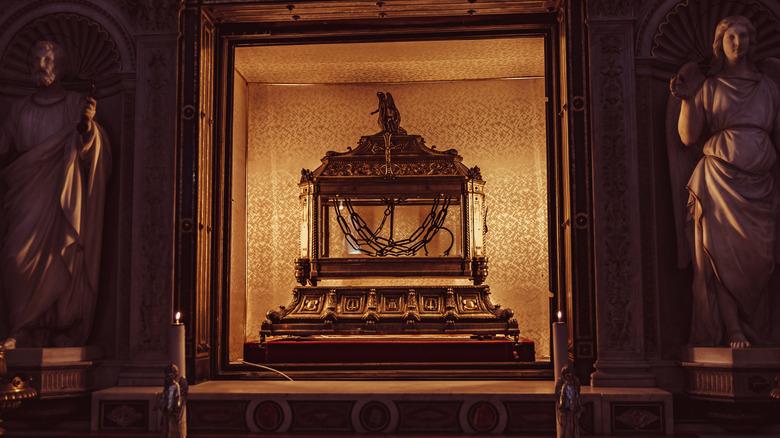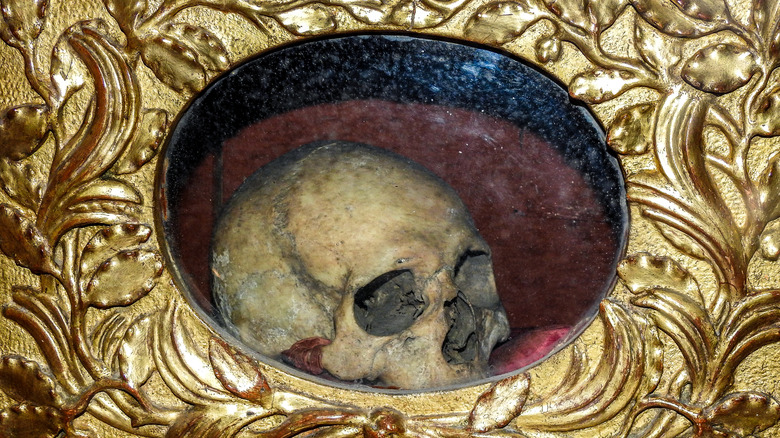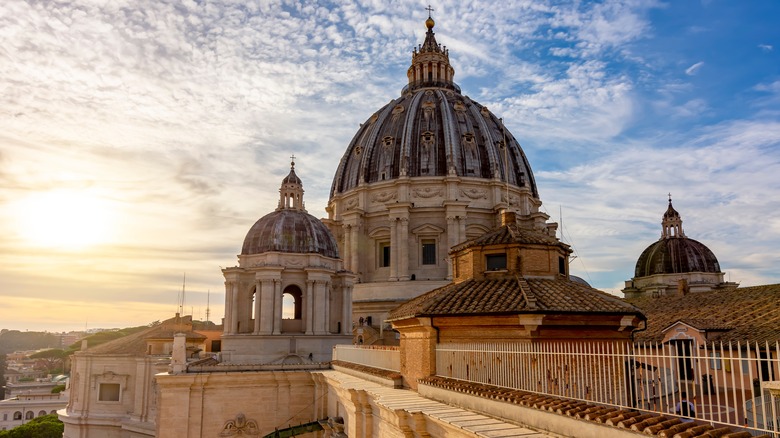How Is A Catholic Relic Made?
Every Catholic church is supposed to house at least one of three kinds of relics: a literal piece of a dead saint's body (a first-class relic), something that saint owned (a second-class relic), or something that touched a first- or second-class relic (a third-class relic). The next time you head to mass, feel free to gaze at the altar and imagine what skeletal goodies lurk inside.
Catholics housing remnants of the holy dead is nothing new. Back in 787 C.E., hundreds of bishops sat down at the Second Council of Nicaea to codify Christian belief, including the use and function of relics. They wrote (via Papal Encyclicals Online): "If in future any bishop is found out consecrating a church without relics, let him be deposed as someone who has flouted the ecclesiastical traditions." All this begs the question: How does one "make" a relic? Well, first-class relics are the bones of the dead, so we can't go around retrieving those from vending machines. Same goes for second-class relics. Third-class relics, however? Believe it or not, as the National Catholic Register writes, you can just ask a priest. Touch an unholy bone to a holy bone, and presto: two holy bones.
New relics generated annually
To clarify, it's not possible to "make" a first- or second-class relic — only a third-class one. However, the argument could be made that when the Catholic Church canonizes a saint they are "making" a first-class relic, i.e., the body of the newly sainted dead. And yes, there is a very precise and regimented four-step procedure for canonizing a saint: "local request," "Vatican review," "beatification," and "canonization." As The Washington Post outlines, there are also two types of saints: confessors and martyrs. The former lived lives of "heroic virtue," while the latter died for their beliefs. The church also requires two miracles, first for the third step, "beatification," and then again for "canonization."
Canonization not only happens to this day but happens more often than before. Britannica reports that the Catholic Church has sainted more than 10,000 people over its lifespan, which depending on who you ask dates to the birth of Jesus. Almost one-tenth of those sainted were canonized in the past 10 years alone — as of March 13, 2023, ChurchPop says Pope Francis sainted 911 people, a number far outstripping any previous pope. Each one of those bodies is full of first-class relics, i.e. future desiccated bones, tufts of hair, etc. And if you nicked the shirt of one of those future saints during his or her lifetime? You've got yourself a dishonest-to-goodness second-class relic. That is, if you think that canonization "makes" relics and doesn't merely acknowledge what the divine already did.
Making a third-class relic
On the National Catholic Register writer Shaun McAfee describes making a third-class relic somewhere in Italy. He simply walked up to a priest he saw at a service and asked (respectfully) to convert a crucifix he'd gotten in Nagasaki, Japan into a relic. The following Sunday he brought this crucifix with him to church, the priest brought out a reliquary containing multiple relics, and the author chose a "little shard of bone" of St. Dominic: a first-class relic. The priest said a small prayer, touched the bone to the author's crucifix, and that was that. As a small side note: The author can't replicate more relics by touching his relic to this or that object. A third-class relic-to-be has to come into contact with a first- or second-class relic directly.
House of Joppa says that practically anything can be made into a third-class relic: books, photos, rosaries, jewelry, you name it. The website also says that some churches host events where "traveling relic groups" bring their artifacts. At that time visitors are basically free to touch whatever they want to the holy objects on display. Catholic Doors says that while there's no official documentation for these types of personal third-class relics, the Catholic Church does keep records for the relics that it itself produces. At minimum, regardless of any supernatural power, relics at least act like keepsakes. If they don't come with a certificate of authenticity, they certainly do come with creation stories.


